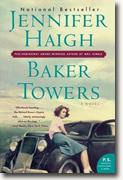Baker Towers
Jennifer Haigh
book reviews:
· general fiction
· chick lit/romance
· sci-fi/fantasy
· graphic novels
· nonfiction
· audio books
· author interviews
· children's books @
curledupkids.com
· DVD reviews @
curledupdvd.com
newsletter
win books
buy online
links
home
for authors
& publishers
for reviewers

 |
Baker Towers Jennifer Haigh HarperPerennial Paperback 416 pages December 2005 |
|
Baker Towers, the second book from novelist Jennifer Haigh, is a compelling saga of a Polish-Italian family, the Novaks, with five children who come of age in a Pennsylvania coal-mining town during and after WWII. Head of the household Stanley Novak drops dead one afternoon after returning from the mines, leaving his Italian wife, Rose, to struggle on her own to feed her children and maintain the household. Oldest son Georgie is in the military at the time of his father’s death while the remaining children are at home. Second child Dorothy takes a job in Washington, D.C., to help support the family, and Joyce, Sandy and Lucy remain at home to finish their educations.
Haigh is also skilled at portraying small-town life of the era: life on “Polish Hill,” one of the ethnic neighborhoods of company housing where the Novaks make their home, the Italian side of town, and, a bit less so, the Protestant part of town. In a small town such as Bakerton, lives revolve around the church, family, local gossip and the mines. The monotony of the days is broken by the occasional festival or miner’s baseball game; throughout the narrative, the reader gets a vivid description of a real small town of the day. While Haigh’s descriptions of the town and the era are full of life, her character descriptions are less vivid. Chapters on each character are interwoven with details of the town and its times, and occasionally the narrative leaps confusingly from present into past, and then into the future. Character motivations are never fully revealed; daughter Dorothy begins as an independent spirit who leaves the only possible job in Bakerton, the dress factory, for a government job in Washington, D.C., and towards the middle of the book has a nervous breakdown. There is little, if any, foreshadowing of this impending breakdown; it simply seems to happen one day, out of the blue, leaving the reader to wonder quite why, after years of Washington life, she could no longer manage. Son Sandy is the least well-developed character; early on it is apparent that he has missed out on the strong, confident guidance of his father in his life, and he has turned into a slacker. He leaves Bakerton as quickly as he can for a mysterious life in Chicago and Hollywood, appearing occasionally to hide out from some unknown danger in his life. The reader is never fully sure what Sandy is doing with himself or what these perceived dangers are, which can be frustrating. Though her characterizations could be stronger, Haigh does develop the tensions of the male and female roles of the time. While Sandy and Georgie have the option of escaping Bakerton and the mines, Dorothy and Joyce have fewer options. Through the war effort, Dorothy escapes Bakerton for a time while Joyce, who longs to go to college but knows her mother can’t afford it, decides that military service is her way out. Joyce finds that the military is not to her liking, and after her mother becomes ill uses it as a reason to escape the military and head home, where she works initially in the dreaded dress factory, then as a secretary at the local school until she can slowly earn certification as a teacher. Daughter Lucy, much younger than her siblings, is sent to college on Joyce’s savings, though she is never truly sure that college was her choice. Though Joyce wants Lucy to escape Bakerton, Lucy wants to stay, causing friction between the sisters. In describing Bakerton, Haigh accurately portrays so many of those small American towns that struggled with changing times, from the ‘40s and ‘50s through the present day. Many readers will recognize their own hometowns in the pages of this book, as well as the many social changes one town and family endure through the years. While Haigh’s characters could be more fully realized, Baker Towers is still an excellent read. Originally published on Curled Up With A Good Book at www.curledup.com. © Virginia Williams, 2005 |
| Also by Jennifer Haigh: |
|
|
|
 Click here to learn more about this month's sponsor! |
|
| fiction · sf/f · comic books · nonfiction · audio newsletter · free book contest · buy books online review index · links · · authors & publishers reviewers |
|
| site by ELBO Computing Resources, Inc. | |
 Haigh’s description of Bakerton, the coal town of the book, is vivid and accurate. She portrays Bakerton during coal’s heyday and beyond to depict the changes mining towns underwent with the passage of time. Haigh shows the reader the many effects that mining had on the worker’s health, company changes and resistance to unionizing efforts, and an eventual tragic accident which, decades later, foreshadows the end of the town’s coal mining days.
Haigh’s description of Bakerton, the coal town of the book, is vivid and accurate. She portrays Bakerton during coal’s heyday and beyond to depict the changes mining towns underwent with the passage of time. Haigh shows the reader the many effects that mining had on the worker’s health, company changes and resistance to unionizing efforts, and an eventual tragic accident which, decades later, foreshadows the end of the town’s coal mining days.